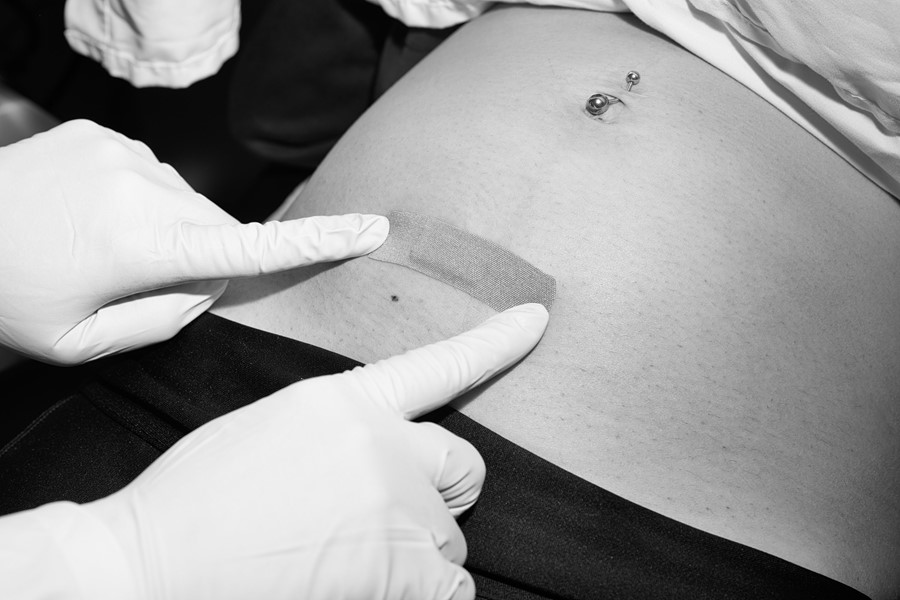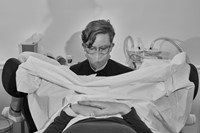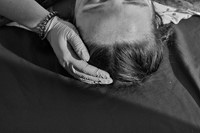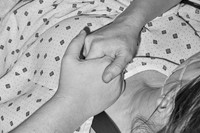Captured at a late-stage abortion clinic in Baltimore, Maggie Shannon’s photo series highlights the subtle moments of care and tenderness during procedures
Photographer Maggie Shannon describes the series she shot at a late-stage abortion clinic in Baltimore, Maryland between 2022 and 2023, as a love story. Certain preconceptions about the subject matter might make this statement surprising, but Shannon’s images of practices at the Partners in Abortion Care clinic are unique in their careful, caring presentation of female healthcare.
The series, entitled A Safe Haven for Late Abortion – black and white scenes shot with moving flash – shed light on the details of this type of care, in ways she considers crucial to capture. Concern is shown only in the slightly furrowed brow of a nurse’s masked face. A single plaster applied to the base of a swollen belly is secondary to the patient’s navel piercing; their identity is hidden, but their personality shines through. It is a significant reminder of the individuality of each patient. We see tenderness and compassion in a clean, quiet, expert curative environment. Shannon presents a safe haven for women to choose, regardless of the surrounding circumstances.
Debate around abortion rights and, in particular, the controversy around late-stage abortions, still swirls, not only in the US. When we speak, Shannon is quick to point out the value of storytelling through imagery during this crucial election year and the dangerous fallacies mentioned by the Republican candidate in a recent TV debate.
The shades of grey in the images are just as important as the revelatory use of light and shadow – while Shannon intends for the series to illuminate and celebrate those dedicated to preserving reproductive rights, she’s also sensitive to the pain.
Below, in her own words, Maggie Shannon tells AnOther about capturing this unconventional love story, showing “love despite grieving, love for bodily autonomy, and love beyond polarised political sides”.
“I think it started the day Roe was overturned in the US. I remember walking around my apartment and just feeling rage, wanting to punch a pillow. I got a newsletter from The Feminist Midwife and she was talking about Partners [in Abortion Care], a clinic which was in the process of opening, and asking for funding. That piqued my interest. I was curious as to what opening an abortion clinic right after Roe was overturned looked like. It felt like a much more productive way to funnel my rage, photographing a story that was uplifting people who were doing incredible work.

“Some of my favourite stories are when you start with an idea, but then something beautiful happens where it becomes so much deeper. You meet people and their stories become more powerful than the original news peg or pitch that attracted you. We’ve all seen photos of people protesting outside abortion clinics and the agony and pain in this whole process – whether you’re a patient or staff. [It’s an] incredibly stressful time we live in, in the US right now. It’s more interesting to me to photograph the love there, and the joy that can happen.
“The relationships at the clinic, with both patients and staff … they meant so much to me. It was such a special thing to meet someone going through this experience, to have them sit with me and answer my questions. I got to know them all really well. Trust builds over time, and you have to show that you’re there to tell their story. A lot of the women I met, before they understood that I would hide their identity, were very against it. But once I explained, your face wouldn’t be shown, any defining marks or tattoos wouldn’t be shown, they were like, ‘Oh, fuck yeah, of course I’ll do it.’ I want to help people understand this procedure. They were all such advocates, and they wanted everyone to understand that the clinic and the staff were amazing. And that this procedure is health care.
“I move the flash around [when shooting] because I love how shadows create depth. It hints back to old FLSA photography, and how historic this moment is. The flash is so important to me, but sometimes it makes it scary. Someone wrote that, in the images, the flash and the shadow represent women coming out of the shadows to provide this care and to shed light on late-stage abortion.
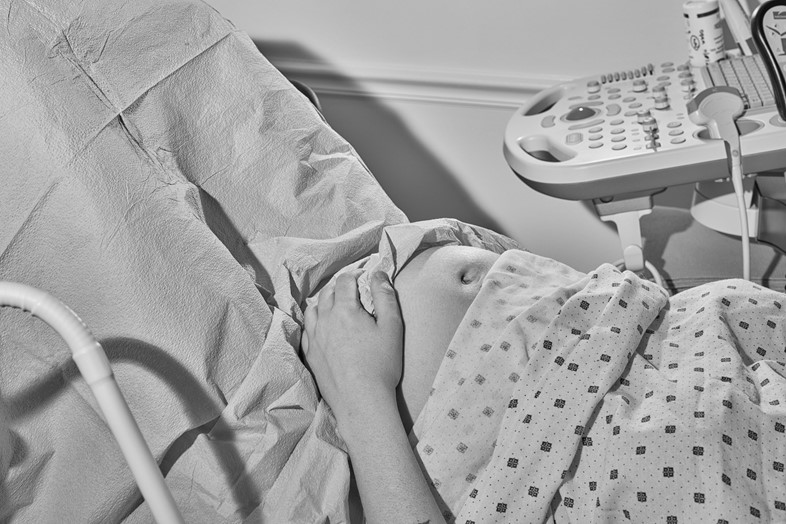
“I show the faces of the staff and their focus. When they knew to reach out and touch someone’s knee, when a patient needed that moment of touch and support, versus [the images] being about bodies and a more medical focus. I think the medical aspect is so important because I learned about all these different tools and how our bodies work and what this procedure is like, but I don’t know if that’s the sole focus. Care is the priority for me with this story.
“After the first trip, being in the room and seeing the full procedure over the course of three days, I came home feeling really sad. I felt angry at myself too, for feeling that way, because it felt like I was siding with the pro-life folks. It took a long time to process that it’s okay to feel sad. I had a long conversation with one of the founders, too. That the sadness is real: it’s sad, but there’s also joy and relief. And that makes this grey, it’s not a black and white thing at all. And that’s why it’s also so powerful too: we’re holding all these different emotions.”
